The AnandTech Coffee Lake Review: Initial Numbers on the Core i7-8700K and Core i5-8400
by Ian Cutress on October 5, 2017 9:00 AM EST- Posted in
- CPUs
- Intel
- Core i5
- Core i7
- Core i3
- 14nm
- Coffee Lake
- 14++
- Hex-Core
- Hyperthreading
Benchmarking Performance: CPU Legacy Tests
Our legacy tests represent benchmarks that were once at the height of their time. Some of these are industry standard synthetics, and we have data going back over 10 years. All of the data here has been rerun on Windows 10, and we plan to go back several generations of components to see how performance has evolved.
All of our benchmark results can also be found in our benchmark engine, Bench.
3D Particle Movement v1
3DPM is a self-penned benchmark, taking basic 3D movement algorithms used in Brownian Motion simulations and testing them for speed. High floating point performance, MHz and IPC wins in the single thread version, whereas the multithread version has to handle the threads and loves more cores. This is the original version, written in the style of a typical non-computer science student coding up an algorithm for their theoretical problem, and comes without any non-obvious optimizations not already performed by the compiler, such as false sharing.
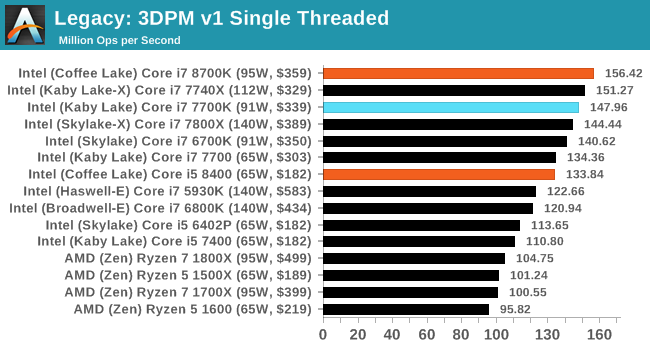
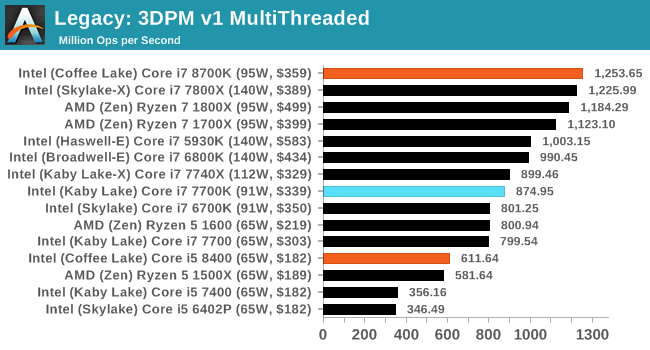
CineBench 11.5 and 10
Cinebench is a widely known benchmarking tool for measuring performance relative to MAXON's animation software Cinema 4D. Cinebench has been optimized over a decade and focuses on purely CPU horsepower, meaning if there is a discrepancy in pure throughput characteristics, Cinebench is likely to show that discrepancy. Arguably other software doesn't make use of all the tools available, so the real world relevance might purely be academic, but given our large database of data for Cinebench it seems difficult to ignore a small five minute test. We run the modern version 15 in this test, as well as the older 11.5 and 10 due to our back data.
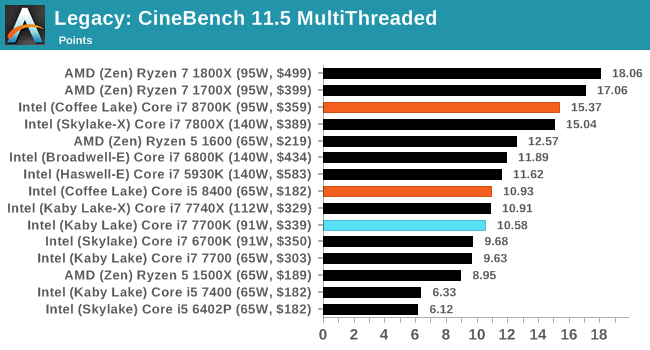

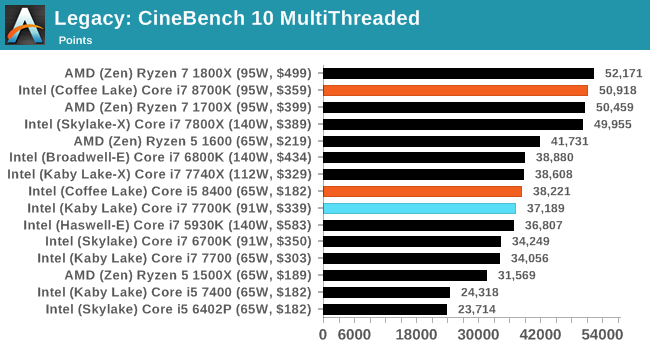
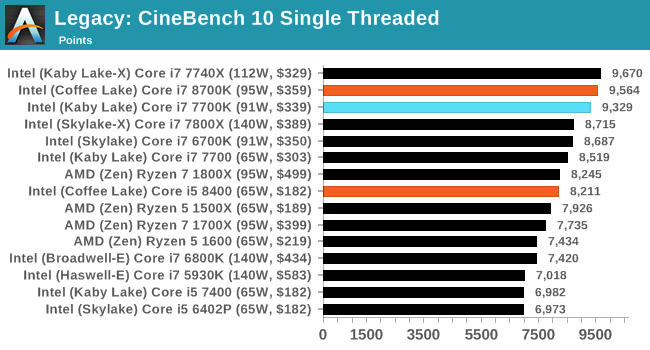
x264 HD 3.0
Similarly, the x264 HD 3.0 package we use here is also kept for historic regressional data. The latest version is 5.0.1, and encodes a 1080p video clip into a high quality x264 file. Version 3.0 only performs the same test on a 720p file, and in most circumstances the software performance hits its limit on high end processors, but still works well for mainstream and low-end. Also, this version only takes a few minutes, whereas the latest can take over 90 minutes to run.












222 Comments
View All Comments
Chaser - Thursday, October 5, 2017 - link
Thank you AMD.vanilla_gorilla - Thursday, October 5, 2017 - link
Exactly! No matter what side you're on, you gotta love the fact that competition is back in the x86 desktop space! And it looks like AMD 1700X is now under $300 on Amazon. Works both ways!TEAMSWITCHER - Friday, October 6, 2017 - link
I just don't see it this way. Since the release of Haswell-E in 2014 we've had sub $400 six core processors. While some like to compartmentalize the industry into mainstream and HEDT, the fact is, I built a machine with similar performance three years ago, for a similar price. Today's full featured Z370 motherboards (like the ROG Maximus X) cost nearly as much as X99 motherboards from 2014. To say that Intel was pushed by AMD is simply not true.watzupken - Friday, October 6, 2017 - link
I feel the fact that Intel had to rush a 6 core mainstream processor out in the same year they introduced Kaby Lake is a sign that AMD is putting pressure on them. You may find a Haswell E chip for sub 400 bucks in 2014, but you need to be mindful that Intel historically have only increase prices due to the lack of competition. Now you are seeing a 6 core mainstream chip from both AMD and Intel below 200 bucks. Motherboard prices are difficult to compare since there are lots of motherboards out there that are over engineered and cost significantly more. Assuming you pick the cheapest Z370 motherboard out there, I don't believe it's more expensive than a X99 board.mapesdhs - Friday, October 6, 2017 - link
KL-X is dead, that's for sure. Some sites claim CFL was not rushed, in which case Intel knew KL-X would be pointless when it was launched. People claiming Intel was not affected by AMD have to choose: either CFL was rushed because of pressure from AMD, or Intel released a CPU for a mismatched platform they knew would be irrelevant within months.There's plenty of evidence Intel was in a hurry here, especially the way X299 was handled, and the horrible heat issues, etc. with SL-X.
mapesdhs - Friday, October 6, 2017 - link
PS. Is it just me or are we almost back to the days of the P4, where Intel tried to maintain a lead really by doing little more than raising clocks? It wasn't that long ago there was much fanfare when Intel released its first minimum-4GHz part (4790K IIRC), even though we all knew they could run their CPUs way quicker than that if need be (stock voltage oc'ing has been very productive for a long time). Now all of a sudden Intel is nearing 5GHz speeds, but it's kinda weird there's no accompanying fanfare given the reaction to their finally reaching 4GHz with the 4790K. At least in th mainstream, has Intel really just reverted to a MHz race to keep its performance up? Seems like it, but OS issues, etc. are preventing those higher bins from kicking in.KAlmquist - Friday, October 6, 2017 - link
Intel has been pushing up clock speeds, but (unlike the P4), not at the expense of IPC. The biggest thing that Intel has done to improve performance in this iteration is to increase the number of cores.mapesdhs - Tuesday, October 10, 2017 - link
Except in reality it's often not that much of a boost at all, and in some cases slower because of how the OS is affecting turbo levels.Remember, Intel could have released a CPU like this a very long time ago. As I keep having to remind people, the 3930K was an 8-core chip with two cores disabled. Back then, AMD couldn't even compete with SB, never mind SB-E, so Intel held back, and indeed X79 never saw a consumer 8-core part, even though the initial 3930K was a XEON-sourced crippled 8-core.
Same applies to the mainstream, we could have had 6 core models ages ago. All they've really done to counter the lack of IPC improvements is boost the clocks way up. We're approaching standard bin levels now that years ago were considered top-notch oc's unless one was definitely using giant air coolers, decent AIOs or better.
wr3zzz - Thursday, October 5, 2017 - link
I hope Anandtech solves the Civ6 AI benchmark soon. It's almost as important as compression and encoding benchmarks for me to decide CPU price-performance options as I am almost always GPU constrained in games.Ian Cutress - Saturday, October 7, 2017 - link
We finally got in contact with the Civ6 dev team to integrate the AI benchmark into our suite better. You should see it moving forward.